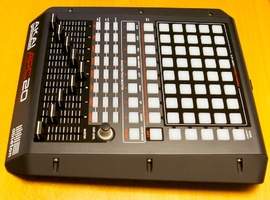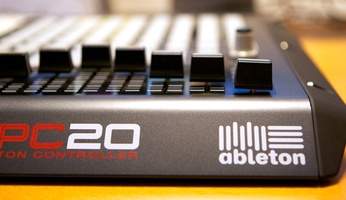With the APC40, a control surface fully dedicated to Ableton Live, Akai created an extremely successful tool, so the launch of the APC20 comes as no surprise: an APC40 amputated of its right section and sold at half the price, to beat all competitors.
Because Akai has serious competitors: also targeting Ableton users, Novation didn’t try to compete with the APC40 on the features front but rather, on the price side, with its more basic Launchpad (only pads, no faders nor rotary controls) for under (the psychological price barrier of) $200. It wasn’t a surprise to see that anyone who didn’t have the money for the big Akai controller jumped at the Launchpad. This was enough to get on the nerves of MPC’s inventor who decided to answer with the APC20 available for less than $200. Let’s have a closer look…
No Surprises
Once you take it out of its big box, the APC20 makes a quite good impression. Made out of metal, it’s neither too heavy to be transported in a backpack nor too light to keep steady on a table (thanks to four wide rubber feet). Plastic is only used for the pads, the switches, the faders, the encoder, and the removable sides of the housing. The latter are held by six screws and thus can be easily removed for rack mounting purposes. We can easily imagine it between two turntables and a small mixer to rock the dance floor with hot loops.
The APC20 features eight channels, each of them with the following controls (from bottom to top): fader, “Record Arm” button, “Solo/Cue” button (for routing the solo track to the monitoring bus), and “Activator” button (for channel on/off). Next to the eight tracks, on the right, a fader controls the master volume while an encoder adjusts the monitoring level.
Above this section, nine pads give access to the main controls: play, stop, record, MIDI overdub, left/right/up/down buttons to navigate within the tracks and the scenes, and “Note Mode” to determinate the operation of the 8×5 pads on the top section of the APC 20. Although their main use is as clip triggers, they can also be used as a “MIDI keyboard” in Note mode, in which case each pad is assigned to a note. Even though it can’t replace a real master keyboard if you want to play melodic instruments, this feature is very convenient to program Ableton’s Drum Rack on the fly.
As Long as there are Pads
The upper section includes 40 pads, plus a column on the right side that allows you to start a scene (comprising all clips in the same row) and a “Clip Stop” row to stop all clips on a track after the loop they are assigned to has been played from start to end. Last but not least, a “Shift” key gives you access to a second function implemented on most buttons of the unit. This allows you to control, for example, the volume, the pan and the three send busses easier. But the most interesting thing about this Shift key is that it allows you to switch the 8×5-pad matrix between Clip Launch and Session modes. Explanation: in Clip Launch mode, each key is assigned to a clip. The pad is off when no clip is present, amber when a clip is loaded but doesn’t play, green when the clip is playing, and red when the clip is recording.
In Session mode, which you access using the Shift key, each pad stands for an 8×5-pad matrix. The pad is off when no clip is loaded in the matrix, amber when the matrix includes clips, green when clips are playing, and red when clips are recording. Once you get used to this concept, the system turns coherent and very convenient since it allows you to multiply the control possibilities of the APC: you get up to 40 matrices of 40 pads, for a total of 1,600 clips… In short, the small APC is actually bigger than it seems and this is verified once you use it with Live.
In Use
Once you plug it to the mains (with the power supply provided) and to the computer (with the USB cable included), just register the control surface in Live’s preferences to start playing — do note that a light version of Ableton’s sequencer is provided as part of the software bundle. The controller is fully mapped and it is as intuitive as Live, so you’ll feel at home right away. And it’s good so because the “documentation” included is a three-page quick start guide…
The APC is immediately ready to use and it is very practical, in spite of the size of the pads (it’s miles away from an MPC in this respect). All faders provide the same well-calibrated feel, the keys respond well and they never block. If we can quibble a bit, we would prefer a brighter back light intensity (I started this test under the sun and the color of the pads was hardly recognizable). However, it’s not crucial because you’ll use the APC in dark environments most of the time.
If you intend to use it for more generic purposes, we have to mention that the pads are not velocity or aftertouch sensitive. This means that the APC is convenient to trigger loops or to program an electro drum machine but not to control a BFD or a keyboard based instrument. And also notice that the APC20 is not very convenient to control effect plugins, considering that it has only one encoder. For such applications, the APC40 is much better equipped with its right section fully packed with encoders.
Conclusion
Yes, the APC40 is much more comprehensive than the APC20! But if you have only $200 for a Live controller, the APC20 has only one competitor in the form of the Novation Launchpad. The latter is less expensive but doesn’t have any faders, which makes it less interesting. However, its larger pads make it more comfortable to use. The perfect product doesn’t exist, even if the numerous pros of both competitors provide unprecedented comfort of use with Live.
- More comfort of use with Live
- Plug and play
- Attractive price
- Manufacturing quality
- The faders offer a small advantage over the Launchpad
- It would be better with rotary controls, like on the APC40…
- Backlit pads hardly readable in bright environments





